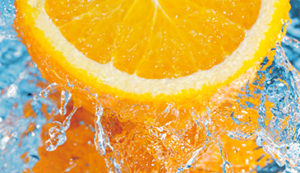
fresh orange in streaming water
Clear thinking, moist skin, healthy kidneys, and bountiful energy — they all depend on an adequate daily intake of water. Are you getting enough liquids? And if you work out, are you getting the right kind? Find out why you should look before you gulp.
When 23-year-old exercise physiology student Julie Moss crawled, staggered and clawed her way across the finish line at the 1982 Ironman Triathlon in Hawaii, her struggle became one of the most iconic moments in modern sports history. Spectators, including millions watching at home on television, were awestruck by her courage, stubborn unwillingness to quit and obvious suffering. What few realized, though, was that her ordeal could have been avoided. Throughout the 10-hour-plus race, she had drunk too little and, for the most part, had consumed the wrong fluids. By the end, she was critically dehydrated and also dangerously low on blood sodium.
Sports science was not as advanced then, and even people like Moss, who were trained in physiology, didn’t understand how critical proper hydration is to performance, basic health and sense of well-being. They thought you could simply drink when you became thirsty and choose whatever fluid appealed to you.
Even today, when we know much more, the medical tents at marathons and triathlons and the ranger stations at national parks are still kept busy treating scores of dehydrated runners, cyclists and hikers who have misjudged their need for fluids.
But endurance athletes aren’t the only ones who suffer. While it’s true that without enough water, exercise is harder and less effective than it should be, even everyday life can be more stressful if you’re running a quart low. On a long run or under bad conditions, improper hydration can become dangerous, even deadly – although that’s rare. Most often, people just start feeling lethargic or vaguely uncomfortable, not understanding that their bodies are becoming desperate for a drink.
WHY WE NEED TO DRINK
The human body is approximately 60 percent water. This fluidity is important in virtually every bodily function. The chemicals vital for cell function are diluted in water, in and between our cells. Our kidneys produce hormones that balance the amount of water in and around the cells to keep them working properly. Mess with the fluid balance in your body, through diet or drink, and you risk upsetting this delicate balance.
Even a moderate level of dehydration has huge effects on your body. Blood, for instance, is more than 80 percent water. When you’re low on fluid, blood literally thickens, making your cardiac system work harder. Less blood flows to the brain, so your mind is not as sharp. By some estimates, only a 2 percent drop in hydration levels can produce fuzzy thinking and impaired memory. Skin becomes drier. Muscles tire and sometimes cramp. Metabolism slows, which, in turn, can lead to weight gain. Because our kidneys use water to carry waste, without adequate fluids the waste can build up in the body. One painful and common result: kidney stones.
The importance of adequate fluid intake for general health was underscored this past January, when the Institute of Medicine (which issues official nutritional guidelines for the United States) released revised standards for hydration. The new recommendations: 125 ounces of fluid every day for men; 91 ounces a day for women. That’s substantially more than the old recommendation of 64 ounces, or eight 8-ounce glasses, of water daily.
While past recommendations said that only water counted toward the daily total, the new version concludes that almost any fluid will do – water, juice, tea or even coffee (coffee and some teas are mild diuretics, so beware of taking this recommendation too far). The primary message is simple, though: Stay hydrated, by whatever means necessary.
WATER FOR WORKOUTS
The importance of those daily ounces increases when you exercise. “Your body is built to function within a certain margin of error, which is obviously narrower during extreme physiologic stress,” says Mark Jenkins, MD, director of student health at Rice University and a team physician for the National Collegiate Athletic Association. You can probably work at your computer when you’re light by a liter and just feel fuzzy. But during a hard workout in high temperatures, every ounce of water counts. Here’s why:
When you work out, your muscles burn glycogen. Heat is one byproduct; your body’s core temperature rises. Because organ health and many bodily functions can become compromised at temperatures only a few degrees above normal, your body has to shed itself of this internal fire. It does this in a number of ways. Like a dog, you begin to pant or breathe hard, removing warmth through your respiration. In addition, blood moves to your extremities – which is why many people look flushed during exercise – carrying some of the excess heat toward the skin’s surface where it dissipates into the air. But by far the most important cooling mechanism is sweat. As sweat evaporates from your skin, it carries off body heat, like a fan directed outward.
So we need to perspire. But the process can become self-defeating. During an hour-long workout in moderate conditions, an average person will sweat out about a liter of water, or about 2 pounds of body weight. That’s approximately one large water bottle. “In hot conditions and with high-intensity exercise, one can lose 2 liters or more per hour,” says Jenkins. Unless you replace the lost water, problems start.
Athletic performance declines about 10 percent with every 2 percent loss of water weight. Your lungs begin to labor. Your heart rate races beyond what it should at that level of exertion. Pulse rates increase by about eight beats per minute every time you lose a liter of fluid. At the same time, your cardiac output – the amount of blood that your beating heart can move through your vessels – declines. Not only do your working muscles receive less oxygen, but less blood flows toward your skin surface and heat begins to build up again at your body’s core. At around a 7 percent water loss, says Jenkins, an athlete collapses.
One thing that probably won’t happen when you’ve sweat out a liter is thirst, which is a notoriously unreliable measure of hydration. “The adage in the cycling community is ‘if you wait until you’re thirsty, it is too late,’” says Jenkins. Most of us don’t have a dry mouth or an urge to drink until we’ve sweated away more than 2 percent of our body weight. (For more on the symptoms of dehydration, see sidebar, “What to Drink and When.”) Perhaps as a result, people often greatly underestimate how much water they’ve lost during exercise.
In a 2001 study of experienced long-distance runners, athletes were asked to assess how much bodily fluid they’d sweated out during a 10-mile race. On average, the runners guessed low by almost 50 percent. Afterward, they voluntarily replaced less than a third of the fluid they’d spent.
It is better, says Jenkins, if athletes learn a hydration routine that they can develop into a habit. “This is so they can train and perform predictably with less risk of dehydration or thermal injury,” he says.
THE SUGAR STORY
To replace the liquid you lose through sweat, and to keep functioning optimally, you need to sip water as you exercise. If your workout lasts an hour or less, there’s no physical benefit to drinking anything other than plain, flat water. Carbonated beverages, including sparkling water, fill your stomach with air, so you feel full and may stop drinking too soon.
If you’re working out from one to three hours, you can improve your performance by drinking a solution containing some carbohydrates. The carbs will help you maintain blood sugar, important fuel for working muscles. Experts suggest, however, that you avoid drinks with a high concentration of carbohydrates or sugars. If your drink is more than 8 percent carbs – or 19 grams of carbohydrate per 8 ounces – it will not empty from your stomach quickly. “A 10 percent sucrose solution cuts gastric emptying in half, compared to pure water,” says Jenkins. The heavy concentration slows the flow of liquid to your laboring muscles, increases the risk of dehydration and can make you nauseous, bloated and crampy.
SALTY SOLUTION
But for heavy exercisers – those who work out longer than three hours, or especially hard for days in a row – sugar takes a back seat to a much more important mineral: salt. On average, you excrete about 2 grams of salt during an hour of moderate exercise. For a person in good health who exercises moderately, that poses no problem because the salt will quickly be replenished, probably at your next meal. But over the course of four or more hours of hard, sustained exercise, sodium loss can become debilitating.
Physiologists often use the analogy of a glass of salt water. Empty half of it, refill it with plain water, and you now have half as much salt. This happens in your bloodstream when you sweat away salt and replace it with only water.
The result is a condition called hyponatremia or “water intoxication.” With too little salt, the delicate balance of chemicals inside and outside of cells becomes disrupted, wreaking havoc with basic body functions. Nerves can’t fire correctly; the person may forget where he or she is or become belligerent. Sensing low sodium in the blood, the body produces a hormone that sends water into the body’s cells, including brain cells, causing them to swell. The brain, encased in the skull, doesn’t have room to swell, cranial pressure rises, and coma, brain damage and even death can result.
Again, this is not a worry for athletes who work out once a day for an hour or less and replenish their minerals and fluids with food and water. But for ultra marathoners, hikers and other athletes who exercise for hours on end, often for days at a time, and who depend on what’s in their water bottle to replenish water and salt, maintaining a fairly precise blood chemistry can be extremely important.
For these athletes, the solution is a solution. Sports drinks and powdered sports-drink mixes contain tasty sugars and salts. One leading brand, for example, has 110 mg of sodium in 8 ounces. Jenkins recommends twice that amount – 220 mg – for bouts of exercise lasting more than three hours.
LEADING YOURSELF TO WATER
Remember, as triathlete Julie Moss learned, without proper hydration, one can barely make it to the finish line, whether of a race, a work project or a day. And Moss did learn. After her 1982 collapse, she went on to win or finish four Ironmans, including the 25th annual Hawaii race last year, with no repeat of her previous dehydration.
Her secret, as revealed in Workouts for Working People (Villard, 2000), the book she co-wrote with her then-husband and fellow Ironman legend Mark Allen, has turned out to be drinking – a lot. Most people, she writes, “drink, at best, about half of what their bodies need.” Not Julie. Now, prior to, during and after a race – and before she worries about food, fans, photos or a shower – she hydrates, often long after she feels no thirst. There’s no choice, she concludes: Hydration is, very simply, priority number one.




